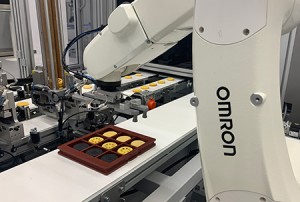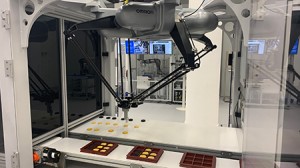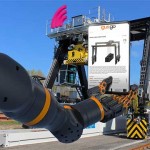Integrated controller makes FMCG mass personalisation a reality
 Omron says it has developed the world’s first automation architecture for personalisation at scale. The Robotic Integrated Controller (RIC) makes made-to-order mass production commercially viable for FMCG businesses for the first time, giving brand owners the power to put consumer preferences at the core of their strategy.
Omron says it has developed the world’s first automation architecture for personalisation at scale. The Robotic Integrated Controller (RIC) makes made-to-order mass production commercially viable for FMCG businesses for the first time, giving brand owners the power to put consumer preferences at the core of their strategy.
Think of a variety pack or a selection box. As a consumer, it is frustrating when you have to buy products you don’t particularly like because they are part of a selection, whether that is the plain digestives in a biscuit tin, the coffee creams in a box of chocolates or the cheese & onion crisps in a multi-pack. Imagine if you could specify exactly what biscuits, chocolates or crisps you want in your variety pack at the point of purchase?
Thanks to a breakthrough by Omron, this personalisation of mass-produced packaged consumer goods is now possible. The RIC is a unique control platform with the ‘brainpower’ to coordinate personalised FMCG production. What could previously only be done manually and on a very limited scale can now be executed via a fully automated workflow – seamlessly, efficiently and profitably. This opens up unprecedented opportunities for the FMCG industry to add value, differentiate and enhance the consumer experience.
The essence of this concept is the ability to empower consumers to self-select the combination of products they want and in the pack formats and sizes they want. There is huge potential for seasonal and special occasion gifting products, such as nail varnish gift sets in colours selected at the point of order, self-picked cheeseboards or gin advent calendars in which the bottle behind each door has been individually chosen for the recipient. Up until now, such products have been very niche and very expensive because they have had to be manually assembled. The RIC makes automated production of these bespoke selections not only feasible but also cost effective.
The opportunity is by no means limited to luxury, niche gifting items. The RIC can be linked with an online retailer’s ordering platform, allowing consumers to select customised versions of everyday items, such as multi-packs of crisps or yoghurts. Consumers could not only choose their preferred product combination, but also their preferred pack size.
Redefining manufacturing flexibility
The personalisation potential promised by this innovation is unrivalled by anything that exists on the automation marketplace today, as Dan Rossek, marketing manager for Omron UK, explains: “The RIC redefines ‘flexibility’ in a production context. There are companies who are supplying flexible manufacturing systems, but their definition of flexibility is making changeovers quick and easy to allow small batch production. What we are talking about here is flexibility at a unit level – the ability to make every single product unique.
“There has been a lot of talk about mass personalisation in the last few years – the big brands have all expressed aspirations to offer made-to-order options to their online customers, but there has been no automation solution to turn these ambitions into anything more than discussions. With the development of our Robotic Integrated Controller, the solution has arrived, and we can’t wait to see how the market embraces this opportunity.”
 By taking a total integration approach, Omron’s engineers have conceived an omni-control unit for these automation elements. Motion, logic, sensing, inspection and robotics are integrated on a common network and programmed via common software. Rather than having a separate PLC, motion controller and robot controller, the RIC controls everything.
By taking a total integration approach, Omron’s engineers have conceived an omni-control unit for these automation elements. Motion, logic, sensing, inspection and robotics are integrated on a common network and programmed via common software. Rather than having a separate PLC, motion controller and robot controller, the RIC controls everything.
From an end user point of view, the entire line can be easily managed from one interface, which makes for highly simplified operation. From a machine builder perspective, development time is massively reduced as the integration of the various automation elements negates the need for protocol development or complex programming.
“Essentially, the RIC enables machine builders to programme the line as a harmonised system rather than programming discrete elements and synchronising them. This level of integration would usually require a prohibitive amount of R&D investment, but because all the different automation elements in our architecture ‘talk the same language’, we have created a plug and play control solution that can support any FMCG line,” explains Dan.
To show what the Robotic Integrated Controller is capable of, Omron has built a demonstration packaging line incorporating this automation infrastructure, housed at its Automation Centre in Barcelona.
This proof-of-concept cell demonstrates the RIC architecture on a pick and place biscuit application. Each customer’s order is translated into a recipe for a specific combination of biscuits and tray size. That recipe is then called up by the RIC system, which tells the tray feeding module to supply the correct tray, the product feeding module to supply the correct biscuits, and the iX4 robot to pick and place the biscuits into the tray. A vision system performs a quality check and verifies that the pack and its contents correspond with the order.
“This demo line shows four different types of biscuits being placed in a number of configurations into three different tray sizes at speed, with full quality control and traceability. It is only the tip of the iceberg in terms of what is possible with a highly integrated control structure, but it proves that mass personalisation is not just a pie in the sky concept but a serious commercial proposition,” says Dan.
Visit the Omron website for more information















